- Quick Read
- Deep Read ( 15 Min. )
Monitor Daily Podcast
- Follow us:
- Apple Podcasts
- Spotify
- RSS Feed
- Download
TODAY’S INTRO
Covering President Biden
Today we take a deep look at President Joe Biden, courtesy of Washington Bureau Chief Linda Feldmann, a seasoned observer of White House occupants.
Linda was there to read the room recently when customers at a Black-owned barbershop in South Carolina found the president of the United States at their elbow during an impromptu visit. She’s talked with Mr. Biden while he chatted up the press on Air Force One. Those are just two of many encounters.
“There’s no substitute for seeing a person up close,” Linda says. “You can look [a president] in the eye – and as famous, pilloried, or misrepresented as they may be, you connect with their humanity.”
As we enter a kickoff week for the presidential race, it’s worth connecting with Linda’s profile of a president.
Share this article
Link copied.

Help fund Monitor journalism for $11/ month
Already a subscriber? Login

Monitor journalism changes lives because we open that too-small box that most people think they live in. We believe news can and should expand a sense of identity and possibility beyond narrow conventional expectations.
Our work isn't possible without your support.
A deeper look
Joe Biden faces the test of a lifetime
President Biden’s decades of experience have brought valuable perspective, supporters say. Yet the next president will face uniquely modern challenges. Is Mr. Biden’s age a liability or an asset? It may be both.

In many ways, Joe Biden’s brand of politics is as old-school as they come. He’s been a fixture in Washington since 1972, and his approach can be seen as a relic of a bygone era, when respect and civility in public life were the norm, and the ability to work across the aisle and cut legislative deals was the name of the game.
Today, after 36 years as a senator from Delaware, eight as vice president, and three-plus as commander in chief, President Biden faces the challenge of a lifetime: fending off likely GOP nominee Donald Trump amid rampant partisan dysfunction and major challenges at home and abroad. The 81-year-old president’s job approval rating is consistently under 40%, weighed down in part by persistent questions about his stamina and sharpness.
In his State of the Union message Thursday night, Mr. Biden will have his biggest opportunity before the November election to address a national audience – and woo back supporters. But it’s likely to take more than a prime-time speech to turn opinion around.
“What Biden wants is a government that works, and that sense of normalcy,” says Democratic strategist Peter Fenn, who has known the president since the 1970s. “A return, in the next four years, of decency and respect for truth.”
Joe Biden faces the test of a lifetime
Joe Biden exits the Beast – the president’s heavily armored stretch limousine – and makes his way into the Regal Lounge, a Black-owned barbershop in Columbia, South Carolina.
The space is cramped, but President Biden works the room like a pro. Customers and stylists alike stop everything to greet the surprise guest, here to campaign ahead of the state’s Democratic primary. A member of the Secret Service instructs a barber to put down his razor; after all, he’s cheek by jowl with the leader of the free world.
The setting, of course, is calculated. The largely Democratic Black vote is critical to Mr. Biden’s election prospects in November – as it was in 2020 – and Black men, in particular, have been peeling away from the president’s column.
After a few minutes inside the Regal, we reporters accompanying Mr. Biden are escorted out. But the president stays inside for a full half-hour. This is the Biden way: More than just grinning for the cameras, he needs to shake every hand, pose for selfies, win people over one by one.
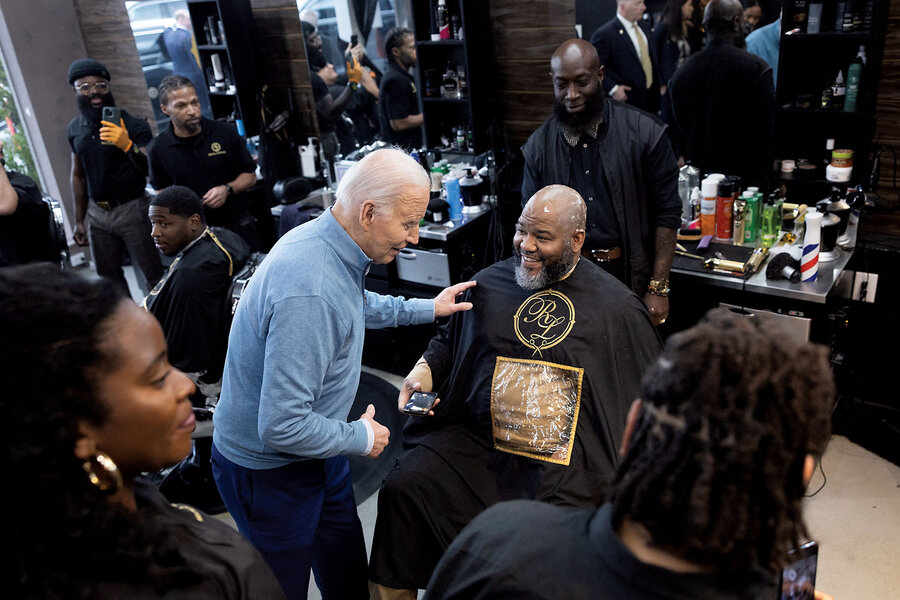
“That’s where Biden is most comfortable” – engaging with the public, says former Republican Sen. Chuck Hagel of Nebraska, a friend of the president’s for 25 years. “He loves people.”
In many ways, Mr. Biden’s brand of politics is as old-school as they come. He has been a fixture in Washington since his first election to the Senate in 1972, and his approach can be seen as a relic of a bygone era, when respect and civility in public life were the norm, and the ability to work across the aisle and cut legislative deals was the name of the game.
Today, after 36 years as a senator from Delaware, eight years as vice president, and three-plus years as president, Mr. Biden faces the challenge of a lifetime: fending off likely GOP nominee Donald Trump amid rampant partisan dysfunction, growing isolationism, a crisis on the southern U.S. border, and an increasingly restive left. His job approval rating with the public is now consistently under 40%.
In his State of the Union message Thursday night, Mr. Biden will have his biggest opportunity before the November election to address a national audience – and woo back supporters. But it’s likely to take more than a prime-time speech to turn opinion around.
A man of the center?
Four years ago, Mr. Biden’s reputation as a moderate, experienced Washington hand who could restore a sense of normality after former President Trump’s tumultuous term helped him win the Democratic nomination and then the presidency.
But that image as a man of the center – able to not only bridge the two main parties but also keep his own side united – has been undercut by the realities of governing in this fractious time. Early in his term, he embraced many of the left’s priorities, going big on pandemic relief spending before touting efforts at deficit reduction. And while the economic picture has grown increasingly rosy, the verdict is still out, and a raft of issues from across the political spectrum – from inflation to the border to Israel – could be his undoing.

Mr. Biden’s ace is that he is tenacious. In his youth, he worked hard to overcome a stutter, a disability he has mostly beaten. He pursued the presidency for decades before reaching the mountaintop. He had to propose to his wife, Jill, five times before she said yes.
He will also do anything, it seems, to protect his family, including his troubled son Hunter, who faces multiple federal indictments on tax and gun charges and a congressional investigation into his business dealings. Republican-led House investigative committees have had the president himself in their sights, but so far have not presented evidence of an impeachable offense.
Now, much like when Mr. Trump asserted at the 2016 GOP convention, “I alone can fix it,” Mr. Biden is displaying a similar mentality. He beat Mr. Trump once and he can do it again, his words and actions suggest – even as the 81-year-old president faces growing questions about his stamina and sharpness.
An ABC News/Ipsos poll, taken right after a February special counsel report depicted Mr. Biden as a “well-meaning, elderly man with a poor memory,” found that a whopping 86% of Americans think Mr. Biden is too old for another term. Some 62% also think Mr. Trump, at 77, is too old. But while the former president also misspeaks regularly, his delivery and physical presence onstage are more robust.
“The visuals are hard” for Mr. Biden, says veteran Democratic strategist Peter Fenn, who has known the president since the 1970s.
Still, Mr. Fenn sees the younger version of the president shining through – a man who believes in his own problem-solving abilities and yearns for the old way of doing things.
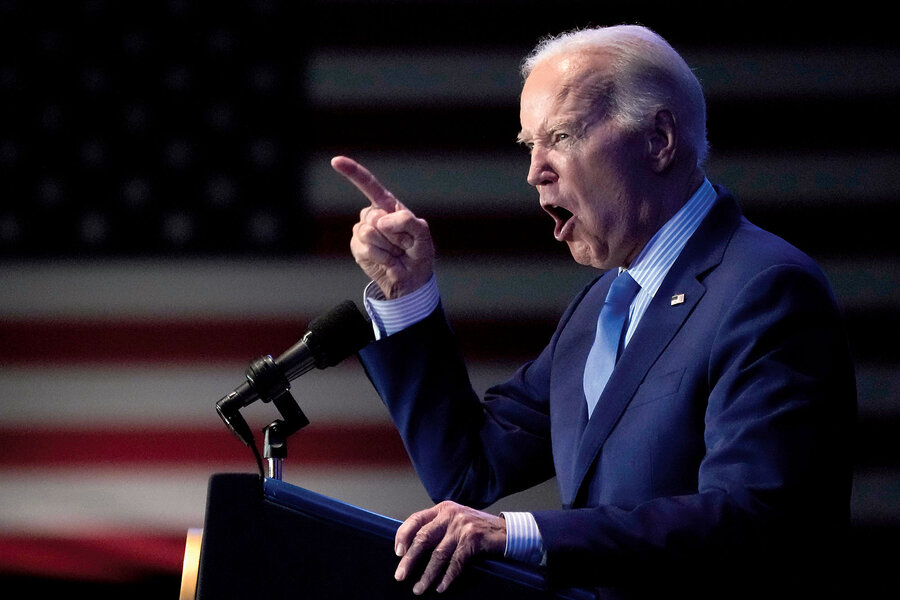
“What Biden wants is a government that works, and that sense of normalcy and regular order,” Mr. Fenn says. “He just wants to set the table for the future – a return, in the next four years, of decency and respect for truth.”
Ultimately, there’s no denying a central paradox of the 2024 election. Mr. Biden is old enough to remember when Black Americans sat at the back of the bus, when the Cold War raged, when TV was in its infancy. And those years of experience have brought a valuable perspective on both how far America has come and where it needs to go, supporters say.
Yet the next president will face the most modern of challenges, from artificial intelligence to climate change. Is Mr. Biden’s age a liability or an asset? The answer may well be both.
Finishing the job
During the last campaign, Mr. Biden strongly suggested he would be a one-termer if he won.
“Look, I view myself as a bridge, not as anything else,” Mr. Biden said in March 2020, right after effectively clinching the Democratic nomination. “There’s an entire generation of leaders you saw stand behind me. They are the future of this country.”
He was referring to then-California Sen. Kamala Harris, New Jersey Sen. Cory Booker, and Michigan Gov. Gretchen Whitmer, all viewed as potential running mates at the time. Vice President Harris got the nod, and today has even lower job approval ratings than Mr. Biden. Some analysts suggest that her weak political standing is one reason Mr. Biden felt compelled to run again.
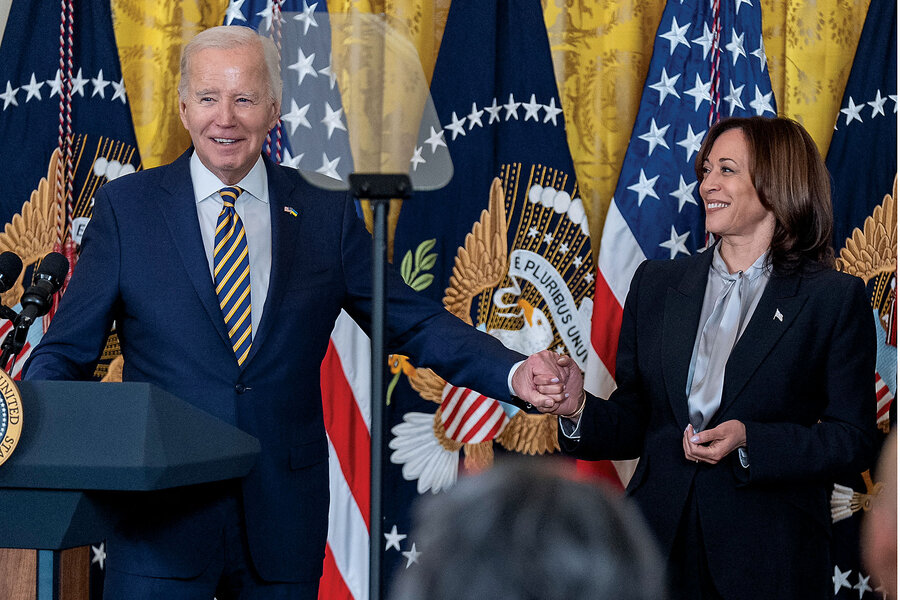
After special counsel Robert Hur declined to charge Mr. Biden for his handling of classified documents – but raised fresh questions about his memory – a CNN reporter reminded Mr. Biden that in December, he had said there are “probably 50” Democrats who could beat Mr. Trump.
“So why does it have to be you now?” the reporter asked.
Mr. Biden’s response: “Because I’m the most qualified person in this country to be president of the United States.” And, he added, to “finish the job I started.”
Ted Kaufman – a close friend of Mr. Biden’s and a decadeslong Senate aide – says he’s not surprised Mr. Biden is going for a second term.
“It’s not an ego thing,” says former Senator Kaufman, who was appointed to Mr. Biden’s Delaware seat for two years after his boss won the vice presidency. Rather, Mr. Biden’s thought process boiled down to this: “How would he feel if he didn’t run, and Trump got elected president? What would that be like in terms of his golden years, and how he lives out the rest of his life?”
That mindset permeated Mr. Biden’s thinking when he ran against Mr. Trump in 2020, and he feels it just as strongly now, Mr. Kaufman says.
Mr. Biden’s friend also points to a life marked with tragedies that have forged resilience. There was the car crash in 1972 that killed his first wife and baby daughter, leaving him as a single parent with two young sons; two life-threatening medical emergencies; the death of his son Beau, who was a rising political star in his own right; and his son Hunter’s addiction and legal problems.
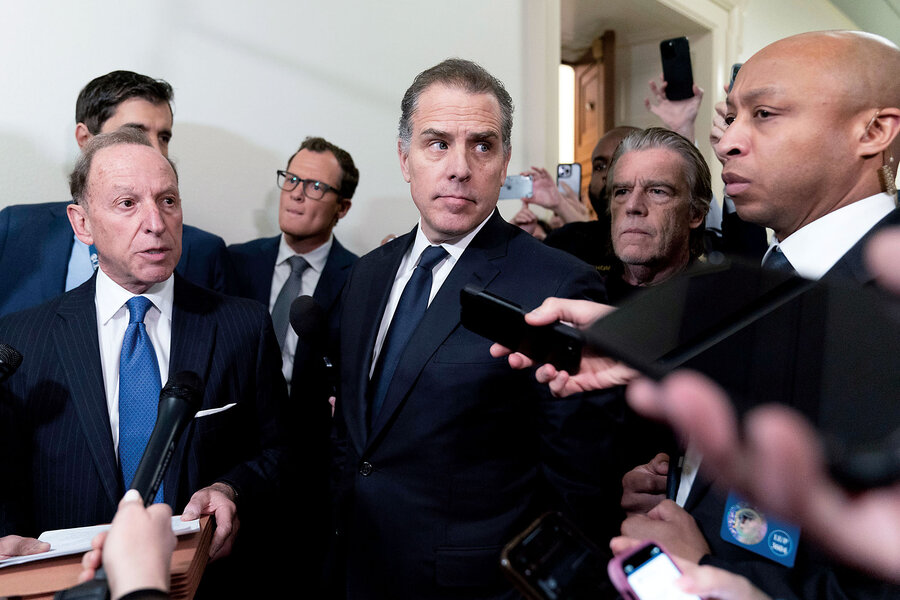
“What all that does to someone, in my experience, is it builds character,” Mr. Kaufman says. “I’m not saying all politicians lie and steal; that’s not been my experience. But he’s faced some incredibly difficult things, things that would daunt anyone else.”
Democrats say Mr. Biden has a strong record of accomplishments to tout. Despite enormous economic challenges coming out of the pandemic, a long-predicted recession never materialized, and January marked the 24th straight month with unemployment under 4%, which is considered full employment. Still, the sharp spike in inflation early on left many Americans feeling poorer, and the lingering effects could harm the president’s efforts to win back blue-collar voters.
Mr. Biden also points to student loan forgiveness and price reductions for some prescription drugs under Medicare as big wins. And he notes that infrastructure projects funded under the $1.2 trillion Bipartisan Infrastructure Law are underway, as are investments addressing climate change via the Inflation Reduction Act.
But there’s no denying a top political liability – the crisis on the southern border, where illegal crossings have averaged a record 2 million a year since Mr. Biden took office. Mr. Trump effectively killed bipartisan border legislation recently in the Senate by voicing his objection, leaving the president to address the issue without congressional help. Trump critics say the former president wants continued border chaos on Mr. Biden’s watch, rather than a solution.

Mr. Biden’s wish list for a second term is long and ambitious – and focused on bringing down costs for Americans struggling to make ends meet. Highlights include federal money for child care, as pandemic funds dry up; an expansion of the reduction in some prescription drug costs to cover all Americans; and free prekindergarten and community college. To pay for this, Mr. Biden proposes raising taxes on wealthy people.
More broadly, the president’s campaign for a second term is centered on nothing less than the preservation of democracy – or what Mr. Biden calls “a battle for the soul of America.” Four years ago, he ran to defeat Mr. Trump and restore, as he likes to say, a sense of common national purpose. Today, those same goals hold, but with more overt fears expressed by some that a second Trump term could creep toward authoritarianism.
Perhaps Mr. Biden’s greatest unfulfilled promise from his 2021 inaugural was a pledge to restore national unity – beginning with a call to “treat each other with dignity and respect.”
Discontent on the left
Lately, much of the disunity has seemed to come from Mr. Biden’s own party. He is routinely confronted at public events by unruly left-wing activists over the United States’ handling of Israel and the war in Gaza, as well as climate change.
Some pundits have argued Mr. Biden needs a “Sister Souljah” moment – that is, he should publicly rebuke his party’s most strident wing as a way to reposition himself in the political center. In 1992, then-presidential candidate Bill Clinton took on Black rapper and activist Sister Souljah, helping to rebrand the Democratic Party as not a captive of the left. Sister Souljah had made comments on race that were widely deemed offensive.
But some who know Mr. Biden best scoff at the idea of him taking on left-wing protesters in that way.
“Come on, really?” says Mr. Kaufman. “You think Joe Biden’s going to be spooked by some of these demonstrators?”
Typically, when protesters disrupt his events, Mr. Biden waits for security to escort them out and then calmly resumes speaking. At times he expresses empathy.

“They feel deeply,” the president said at a campaign rally in January, after protesters opposed to U.S. support for Israel’s offensive in Gaza interrupted him about a dozen times.
Supporters say that by not engaging with protesters, he’s showing confidence in his position and a willingness to let the debate be fully aired. But Mr. Biden’s patience can have its limits, as another longtime friend suggests.
“There will come a time in the next eight or nine months where something will happen, and he’ll just say, ‘Enough,’” says Mr. Fenn.
With some top administration officials, protesters have become especially brazen. Since January, dozens of people have camped outside Secretary of State Antony Blinken’s home in suburban Virginia, demanding a cease-fire in Gaza.
Heather Bukhari, a Muslim woman from Chicago, says she won’t vote for Mr. Biden. She cites the nearly 30,000 Palestinians in Gaza, many of them women and children, killed by U.S.-backed Israel since the war began.
“Many of the people in my social circle are totally disgusted with Biden,” says Ms. Bukhari, who drove 13 hours to join the Blinken encampment for a bit.
A successful reelection effort by Mr. Biden will depend on his ability to sew together many constituencies and convince them to turn out. For some young progressives, disillusioned over Mr. Biden’s strong support for Israel following Hamas’ attack on the Jewish state Oct. 7, the choice may not be Biden-Trump; it could be whether to vote third-party – or not at all.
Evolving views
Typically, Mr. Biden responds to the age question in two ways: “Watch me,” and then some version of, “With age comes wisdom.”

Indeed, looking back over his long career, there’s no question that Mr. Biden has evolved both politically and personally.
One example: He learned to stop being “handsy” with people – or “getting a little too close,” as a Biden friend put it. Like many male politicians of his generation, he was once known as a hugger and a backslapper, a habit that could make women in particular feel uncomfortable. But in 2019, as Mr. Biden prepared to run for president, aides had a sit-down with him and he changed his ways.
Another trait that Mr. Biden learned to correct was long-windedness. Democratic Sen. Chris Coons of Delaware, a one-time Biden intern who now holds the president’s old Senate seat, recalls stemwinders that could go on for an hour and a half. Today, Senator Coons says, Mr. Biden does less talking and more listening.
“He changed, fundamentally, as vice president and president,” says Mr. Coons, noting that before Mr. Biden became vice president, he hadn’t had a boss for 36 years. “He’s very disciplined – in meetings, in speeches, in engagement. He reads an enormous amount; he’s very present.”
That’s not to say meetings with Mr. Biden don’t often go long. But that’s because he wants everyone to have their say and invites debate, according to aides.
He also seems to have learned from past mistakes. Mr. Biden served as Senate Judiciary Committee chair during the 1991 Supreme Court confirmation hearing for Clarence Thomas, when allegations of sexual harassment by a former subordinate, Anita Hill, cast then-Judge Thomas’ confirmation in doubt and shined a light on the committee’s makeup: all white men.
The case of now-Justice Thomas and now-Professor Hill, both Black, set the politics of race and gender in sharp relief. And when Chairman Biden made a deal with Republicans that prevented four female witnesses from testifying on Ms. Hill’s behalf, that sealed Mr. Thomas’ confirmation. Years later, in 2019, as Mr. Biden prepared to announce his campaign for president, he called Ms. Hill to express regret. She said it wasn’t enough.
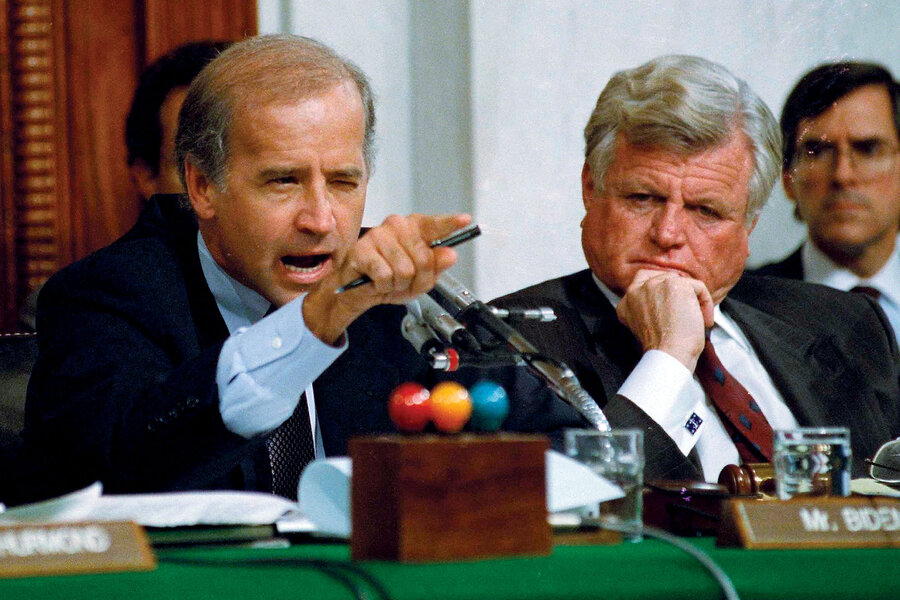
But for Mr. Biden, and the nation, the lessons of the Hill-Thomas hearings reverberated. The election of 1992 became the “year of the woman,” with record numbers of women winning Senate seats. Today, Mr. Biden has made promoting women and people of color a centerpiece of his administration, including Vice President Harris. He touts a Cabinet that “looks like America,” with more women and people of color than any previous Cabinet. The Biden administration has seen more Black women confirmed to federal judgeships than any previous administration, including the first Black female Supreme Court justice, Ketanji Brown Jackson.
Eleanor Smeal, a longtime feminist activist who has known Mr. Biden since the 1980s, says he’s always been a champion for women. In the Anita Hill episode, she says, it was the Republicans on the committee who sought to discredit Ms. Hill’s testimony, not Mr. Biden and fellow Democrats. In 1994, she notes, Mr. Biden was a strong proponent of the Violence Against Women Act, which he has called his “proudest legislative accomplishment” as a senator.
“All I can say is, he has been very, very strong on legislation when it counted,” Ms. Smeal says.
She also calls Mr. Biden strong on women’s reproductive rights, despite his personal opposition to abortion as a devout Catholic. In 1994, as Judiciary Committee chair, he presided over passage of legislation guaranteeing access to reproductive health clinics.
Another past position Mr. Biden has backed away from was his support for the 1994 crime bill, which in 2019 he called a “big mistake,” with its overly harsh sentencing guidelines that disproportionately affected Black Americans.
“He gets it about race and racism,” says Democratic pollster Celinda Lake, who worked on his 2020 campaign. “He’s also very comfortable around LGBTQ rights and gender issues, which weren’t even on the radar for people in the 1990s.”
Ms. Lake credits Mr. Biden’s adult grandchildren, with whom he is close, for keeping him up to date on trends and social issues. In 2012, Mr. Biden was famously a step ahead of his boss, President Barack Obama, in voicing support for same-sex marriage.
His latest foray into modern culture came last month on Super Bowl Sunday, when his campaign joined TikTok after saying it wouldn’t over national security concerns. Campaign advisers have said they’re intent on “meeting voters where they are” – though, notably, the president’s risk-averse White House press team declined to make him available for a Super Bowl pregame interview for the second straight year.
In general, the Biden team has limited his availability to reporters, holding many fewer press conferences so far (33) than Mr. Trump in one term (88) and Mr. Obama in two (163). Mr. Biden’s habit of misspeaking in unscripted moments is nothing new. But the optics today are far riskier.

America’s role in the world
Mr. Trump is of the same generation as Mr. Biden, and neither man served in the military, each having received multiple draft deferments during the Vietnam War. But they have diametrically opposite views on America’s role in the world.
Mr. Biden’s worldview is centered on the internationalist tradition, defending freedom around the world, while Mr. Trump’s posture is that of an “America First” strongman ready to abandon traditional alliances, including NATO.
In his early Senate days, a young Mr. Biden served with many World War II veterans who instilled in him a reverence for military service, regardless of party affiliation. Later, he bonded with Vietnam War vets. The late Republican Sen. John McCain became one of his dearest friends, and today, Mr. Biden and former Senator Hagel remain close.
“When the World War II generation left the scene, in the House and Senate, that created an amazing vacuum,” says Mr. Hagel, who was secretary of defense under Mr. Obama. “I don’t think we even understood what we lost when we lost these people.”
Mr. Hagel says he’s still a Republican, “though I’m not sure why.” He plans to campaign for Mr. Biden. And he acknowledges that the president faces an extraordinary challenge over the Israel-Hamas war, including at home politically.
The former senator notes the importance of the Arab American vote in Michigan – a key electoral battleground state and home to the nation’s largest Arab community. Last month, top White House officials traveled to suburban Detroit to meet with Arab Americans and hear them out.
Mr. Biden’s deep devotion to the state of Israel, going back decades, remains one of those bedrock views that he’s having to weigh against the current state of affairs.
Mr. Kaufman, his longtime friend, explains the Biden love of Israel simply: “It’s because he’s Irish. The Irish have a concern for the underdog, especially Irish Catholics.”
Today, Mr. Biden himself appears to be an underdog in a campaign he describes in existential terms for the nation’s future.
But the race is still young.
Staff writer Caitlin Babcock contributed reporting from McLean, Virginia.
[Editor’s note: This story was corrected to include the last name of Heather Bukhari.]

Today’s news briefs
• France moves on abortion: French lawmakers approve a bill that will enshrine a woman’s right to an abortion in the constitution. The vote in an exceptional joint session of the parliament was 780-72.
• Guilty plea: Former Trump Organization CFO Allen Weisselberg will be sentenced to five months in jail for perjury in a civil fraud case about former President Donald Trump’s financial statements.
• Taking office in Pakistan: Shehbaz Sharif becomes prime minister for a second time, a day after Parliament elected him despite protests from some lawmakers and accusations that the vote was rigged.
• Haiti emergency: Authorities order a nighttime curfew after armed gangs freed thousands of incarcerated people from Haiti’s two biggest prisons. The prime minister is seeking a United Nations-backed security mission, led by Kenya.

Court’s ruling keeps Trump on state ballots. Then what?
The U.S. Supreme Court moved unanimously in deciding that states can’t kick Donald Trump off ballots – and in effect left voters to decide whether the former president’s 2020 election moves are disqualifying.

- Quick Read
- Deep Read ( 4 Min. )
-
Henry Gass Staff writer
Former President Donald Trump’s name will stay on the Colorado primary ballot.
The Supreme Court on Monday ruled the state cannot strike him from its list of presidential candidates on grounds he engaged in insurrection by trying to overturn the 2020 election.
For all practical purposes, the unanimous ruling ends state-by-state attempts to rule Mr. Trump ineligible for the White House under a long-dormant clause of the 14th Amendment that bars insurrectionists from public office.
But some legal experts say that the decision left important aspects of the issue unresolved as to how they apply to politics today. In particular, they say, it did not clarify whether or how Mr. Trump’s eligibility to hold office could still be challenged under the 14th Amendment if he wins.
The ruling left enforcement of the 14th Amendment clause in the hands of Congress.
One of the primary arguments Mr. Trump’s lawyers made was that Section 3 does not mention the presidency, and so does not apply to that office, or Mr. Trump. They also argued that he did not engage in insurrection. Monday’s ruling was silent on both these questions.
Court’s ruling keeps Trump on state ballots. Then what?

Former President Donald Trump’s name will stay on the Colorado primary ballot.
The Supreme Court on Monday ruled the state cannot strike him from its list of presidential candidates on grounds he engaged in insurrection by trying to overturn the 2020 election.
For all practical purposes, the unanimous ruling ends state-by-state attempts to rule Mr. Trump ineligible for the White House under a long-dormant clause of the 14th Amendment that bars insurrectionists from public office.
But some legal experts say that the decision left important aspects of the issue unresolved as to how they apply to politics today. In particular, they say, it did not clarify whether or how Mr. Trump’s eligibility to hold office could still be challenged under the 14th Amendment if he wins.
“They didn’t say it wasn’t an insurrection, he didn’t engage in it, it doesn’t apply to the president – those things that would have clearly resolved it,” says Gerard Magliocca, professor at the Indiana University School of Law.
Ruling lands one day before state primaries
The high court justices fast-tracked their consideration of the Colorado case, Trump v. Anderson. They released their opinion one day before Super Tuesday, when Colorado and a number of states hold their primaries.
The case stemmed from a challenge brought by a number of Colorado voters who asked the state to block Mr. Trump from the primary ballot under the 14th Amendment’s Section 3. That clause bars from public office those who have taken an oath to support the Constitution and then engaged in insurrection or rebellion “against the same.”
The Colorado Supreme Court eventually held that Section 3 did apply to the former president – and that he had engaged in insurrection against the United States.
Mr. Trump then asked the U.S. Supreme Court to take up the case. One of the primary arguments his lawyers made was that Section 3 does not mention the presidency, and so does not apply to it. They also argued that Mr. Trump did not engage in insurrection. Monday’s ruling was silent on both of these questions.
The per curiam, or unanimous, opinion held that states can indeed disqualify state officials they deem insurrectionist. But “states have no power under the Constitution to enforce Section 3 with respect to federal offices, especially the Presidency,” the opinion said.
State enforcement of Section 3 could result in a “patchwork” situation, with an evolving electoral map that could dramatically change the behavior of voters, parties, and electoral results, according to the opinion.
“Nothing in the Constitution requires that we endure such chaos,” the opinion held.
“Per curiam” means, specifically, a unanimous ruling meant to reflect the opinion of the court as a whole and not the ideas or work of a single judicial author. In essence, the decision was 9-0.
That unanimity on the central point of the case is the biggest takeaway from today’s court action, says Josh Blackman, professor at the South Texas College of Law in Houston. “All nine justices agree this was a terrible idea,” he says.
What does “unanimous” mean?
But some unanimous opinions are more unanimous than others, says Alison LaCroix, professor at the University of Chicago Law School.
Indeed, all nine justices agreed that Mr. Trump should appear on the Colorado ballot – but four of them, in separate opinions, said the other five had gone beyond what was necessary in discussing limitations on how the insurrection clause might be enforced.
“It’s a unanimous opinion by any meaningful definition of that term, but it is not the court speaking with one voice, and that is significant,” says Professor LaCroix. The per curiam decision said that the responsibility for enforcing Section 3 against federal officeholders and candidates rests with Congress, not the states.
Specifically, it said that the disqualification clause at the national level can be enforced only through federal legislation, not through a federal court challenge or other nonlegislative action by Congress.
Justice Amy Coney Barrett, a Trump appointee, said in a brief concurring opinion that the majority had gone too far in discussing the “complicated question” of congressional enforcement.
The liberal trio of Justices Sonya Sotomayor, Elena Kagan, and Ketanji Brown Jackson were sharper in their criticism, saying that the per curiam opinion “shuts the door” on other means of federal enforcement. “We cannot join an opinion that decides momentous and difficult issues unnecessarily,” they wrote.
One problem is that simply saying Congress needs to pass legislation to enforce Section 3 is vague, and it does not define what counts as legislation, says Professor Magliocca.
Does existing legislation, such as the Electoral Count Reform Act, count? Would congressional action in a joint session be ruled out?
“In effect, there are these sloppy statements in the majority opinion that don’t need to be there, and it’s confusing,” he says. “I don’t think the four understand what the five are trying to say.”
Some experts worry about potential turmoil in the case of a Trump victory. What would happen if Democrats in Congress object to the counting of Electoral College votes for Mr. Trump, saying he is constitutionally ineligible for office?
After all, in Monday’s ruling the Supreme Court did not rule that Section 3 of the 14th Amendment did not apply to Mr. Trump. In its ruling, the Colorado Supreme Court held that Mr. Trump engaged in insurrection when he summoned supporters to Washington in advance of Jan. 6, 2021, and encouraged them to disrupt the congressional certification of President Joe Biden’s Electoral College votes.
Monday’s per curiam Supreme Court opinion was silent on the matter.
“The court decided that [Mr. Trump’s] innocence [or guilt] was not relevant,” says Mark Graber, professor at the University of Maryland School of Law.

Amid aid cuts, Ukraine families wonder how to get by
With billions of dollars in additional U.S. aid to Ukraine held up in Congress for months, the impact is being felt not only by soldiers at the front, but also by civilians displaced by war and dependent on generosity.

- Quick Read
- Deep Read ( 5 Min. )
As Russia’s invasion of Ukraine grinds into its third year, the uncertain Western cash flow into Ukraine has forced a broad belt-tightening.
Ukraine relies on foreign aid for half of its annual budget. Months of continuing delays in American approval of a $60 billion military and support package for Ukraine is cutting deep, from a shortage of artillery shells to a severe reduction in services.
That is being felt especially acutely by Ukrainian families displaced by war. Indeed, Ukrainian officials say 40% of the internally displaced people (IDPs) depend entirely on monthly state financial assistance for sustenance.
In northwest Kharkiv, Valentyna Idrisova refurbished a student dormitory that had been abandoned for two years. She calls the dorm her “personal combat zone” and says it accommodates 178 displaced Ukrainians, including 28 children.
Donations poured in after the sanctuary was open to IDPs last August, but they began to dry up in November, she says. Most of the residents are retirees who receive a monthly pension of $60, she says, and live on that until the IDP payment comes.
For families, the IDP payments have been a critical lifeline. For most, now, those payments are ending.
“How can you leave these people with nothing?” Ms. Idrisova asks.
Amid aid cuts, Ukraine families wonder how to get by
A budget crunch has brought new levels of uncertainty to the two cramped rooms of a student dormitory in Kharkiv.
There, Ukrainian mother Olha Poltoratska and her four children have been surviving on monthly payments provided to Ukrainians displaced by the war.
For most, those payments are now ending.
“I can’t imagine how I can live without that,” says Ms. Poltoratska, whose son, Ruslan, is 9 months old, has two teeth, and has a taste for the Ukrainian staple, beetroot borscht.
“When I heard that news, I was amazed,” says the distraught mother. “I called my husband and said, ‘What are we going to do? Join the army to get money?’”
Ukraine relies on foreign aid for half of its annual budget, and months of continuing delays in American approval of a $60 billion military and support package for Ukraine is cutting deep, from a shortage of artillery shells on the battlefield to severe reduction in services.
The European Union in late February passed its own delayed package of $54 billion for Ukraine, for 2024 to 2027, which includes some $42 billion in direct budget support. Japan also gave $440 million in the first two months of the year, also for budget support.
But the uncertain Western cash flow to Ukraine has forced a broad belt-tightening, even as Russia’s invasion grinds into its third year and Russian forces go on the offensive.
Ms. Poltoratska first held her breath when Ukraine’s cash-strapped government announced that modest support payments to the legions of internally displaced people (IDPs) would end Feb. 1.
For her, that would have meant losing roughly $50 each for her and her two older daughters, and $75 each for her two small children – a total of some $300 per month. They would then have to get by on $120 per month – the official payment to all mothers of four children.
The cutoff was delayed until March 1, but today Ms. Poltoratska is still holding her breath, unsure if new rules that would continue payments to the most vulnerable people will include her family.

Prices are high, for everything from diapers to vegetables, which they used to grow for themselves on their own plot in Kucherivka, a battle-scarred town just miles from Ukraine’s increasingly noisy northeastern front-line.
Both sides of her family, for three generations, worked at the nearby railroad hub, which is now destroyed. Ms. Poltoratska’s husband has stayed in the town, at the edge of territory liberated by Ukraine in a September 2022 counteroffensive, where he does volunteer work with occasional payment as a mechanic fixing military vehicles.
“Sometimes he comes here, so we don’t forget what he looks like,” says Ms. Poltoratska, who asked that his name not be used for his security. Two rooms in the converted student dormitory hang with drying laundry and are stuffed with cooking tools, a TV, and whatever else could be brought from home.
When the Russians were advancing in early 2022, the first shell to land in Kucherivka exploded in their front yard. Last August, after Russia stepped up air attacks on nearby Kupiansk and Ukrainian soldiers warned of the risk to the children, the family finally left for Kharkiv – Ukraine’s second-largest city, just 25 miles from the Russian border and itself a frequent target of rockets and missiles.
“If we believe what our government says to us, this money will be redirected to the army,” says Ms. Poltoratska. She is not certain, though, that that is where it goes. Her older daughter, Lisa, had been in contact with a soldier from Lyman who told her that for three months in a row, the bulk of his $3,000 monthly salary had been delayed, and that he had instead received a tiny fraction of it.
“Is this normal?” Ms. Poltoratska asks.
For this family and so many others, the cash for IDPs has been a critical lifeline.
“How can you leave these people with nothing?” asks Valentyna Idrisova, who refurbished this student dormitory after it had been abandoned for two years in northwest Kharkiv. She calls the dorm her “personal combat zone” and says it now accommodates 178 displaced Ukrainians, including 28 children.
Donations poured in after the sanctuary was open to IDPs last August, but they began to dry up in November, says Ms. Idrisova. Most of the temporary residents are retirees who receive a monthly pension of $60, she says, and live on that until the IDP payment comes.
“That’s how it goes,” she says. “This is crucial money for them.”
Indeed, Ukrainian officials say that 40% of the displaced people depend entirely on state financial assistance for sustenance. But the cut in IDP payments – which reportedly aims to save $530 million of Ukraine’s annual budget – is just one facet of a broader financial shriveling, which partly stems from delayed Western support.
“Financial aid from the United States is crucial for maintaining macro-financial stability during the war,” Ukrainian Finance Minister Sergii Marchenko tweeted in mid-February, after the Senate approved a long-delayed $60 billion aid package for Ukraine, which included $7.85 billion in direct budget support.
Still, the House has delayed its own vote, with Republicans tying the issue to domestic immigration measures.

In Kharkiv, officials suggest that local budgets may shrink 40% this year. In a region that experienced widespread destruction during the invasion, then months of occupation and the Ukrainian counteroffensive, rebuilding depends on foreign cash – and, of course, the course of the war.
Anton Korotovskykh, director of the Department of Architecture and City Development for the Kharkiv region, lists a string of projects that have been identified for restoration.
“But because Kharkiv is so close to the Russian border and there is shelling every day, most of these projects are in the aspirational phase,” he says. “The main challenge is refurbishing private residences, because people want to go back.”
Last year some 1,500 buildings, including multistory residential complexes, were restored. But with 50,000 buildings and homes damaged or destroyed in the region, “it is going to be a long job,” he says.
“Of course, the biggest challenge is our big and reckless neighbor, which keeps destroying things,” says Mr. Korotovskykh. “So we focus on critical infrastructure like heating and electricity.”
The lack of resources is so profound, for example, that the fund for rebuilding destroyed roads “now is 0.0 – there is nothing,” he says. “We have expectations that this year we will have less for this, because we understand that the entire state budget is put into the military.”
Rebuilding must be done in a holistic way, such that those who might move back to refurbished homes also have schools, hospitals, and other facilities like bomb shelters for children, Mr. Korotovskykh adds.
“Of course we have our fears” about a shrinking or cutoff of Western aid, he says. “We can’t talk of rebuilding without finance.”
Reporting for this story was supported by Oleksandr Naselenko.

Books
An indie publisher finds its future – with a public library
Book publishing involves deciding what titles the public could and should be reading. In an unprecedented but natural alliance, a local press in Los Angeles will now be run by the city’s public library.
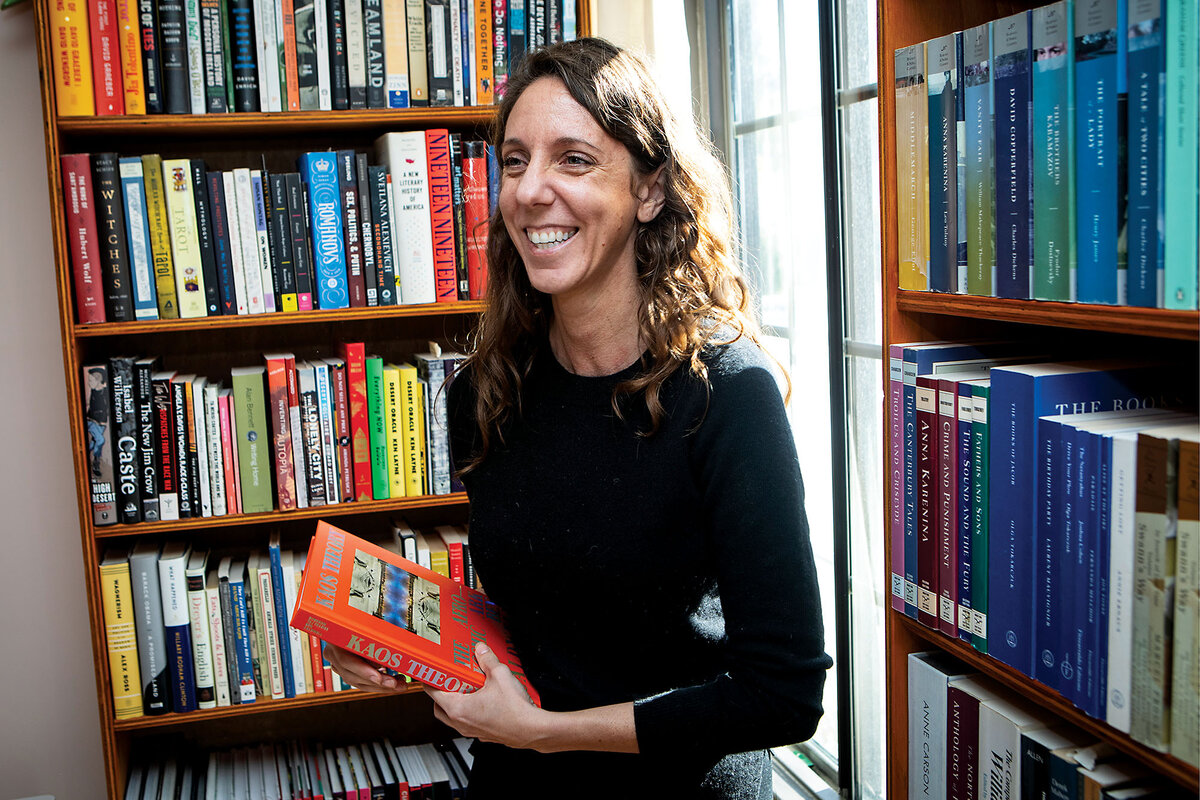
- Quick Read
- Deep Read ( 5 Min. )
-
Melanie Stetson Freeman Staff photographer
The City of Angels is known for glitz and glamour, celebrity sightings, and fairy-tale fantasies. But Angelenos recognize a deeper creative spirit, where stories of resilience are illuminated with quirky, indelible characters.
“There’s something really valuable in trying to reflect a true portrait of the city,” says Terri Accomazzo, editorial director for Angel City Press. “The city is so rich in diversity. It’s so rich in creativity and intelligence. And I just hate to see it pigeonholed the way that it is sometimes.”
For more than 30 years, Angel City Press has published nonfiction by local authors. Now, the company’s founders are handing it all over to the Los Angeles Public Library in an arrangement unprecedented in scope – forging what the city’s top librarian describes as a natural alliance. “The library is about collecting stories,” says City Librarian John Szabo. “And that’s what Angel City Press has done.”
LA’s chief librarian is focused on the opportunities it presents. Mr. Szabo points to e-books, audio books, and children’s books as areas of growth – in a city built on imagination. Angel City’s 135-plus titles are weird, fun, and beautiful, says Mr. Szabo. “It’s about telling stories that might not otherwise be told.”
An indie publisher finds its future – with a public library
The City of Angels is known for glitz and glamour, palm trees, celebrity sightings, and fairy-tale fantasies. But Angelenos recognize a deeper creative spirit, found in its eclectic and diverse neighborhoods, where stories of resilience are illuminated with quirky, indelible characters.
“There’s something really valuable in trying to reflect a true portrait of the city, not just to the people who live here, but [to people] everywhere,” says Terri Accomazzo, editorial director for Angel City Press. “The city is so rich in diversity. It’s so rich in creativity and intelligence. And I just hate to see it pigeonholed the way that it is sometimes.”
For more than 30 years, the small independent Angel City Press has published nonfiction by local authors. Now, the company’s founders are handing it all over to the Los Angeles Public Library (LAPL) in an arrangement unprecedented in scope – forging what the city’s top librarian describes as a natural alliance. “The library is about collecting stories, we’re about preserving stories, and we’re certainly about telling stories,” says City Librarian John Szabo. “And that’s what Angel City Press has done.”
Shared mission
With e-books and self-publishing, getting a book to market has never been easier, says Andrea Fleck-Nisbet, CEO of the Independent Book Publishers Association. The hard part is connecting with an audience.

“By taking a small indie publisher and then being able to continue its life through a nonprofit like a library that’s already serving that market, you have that built-in community,” she says, adding that the partnership offers an exit strategy for publishers who want their mission sustained.
This alignment does just that. Angel City’s donation includes its catalog of published books – titles that might be retired if acquired by a company focused solely on profits, says Ms. Accomazzo, who will keep her position after the transition. It also ensures that the press “continues to operate with an eye toward storytelling and a focus on telling things that matter as opposed to just trying to make as much money as we possibly can.”
Local voices
One of those stories is “A Handful of Earth, A Handful of Sky: The World of Octavia E. Butler” by Lynell George, about the life of the celebrated science fiction writer. Ms. Butler, a Black woman, grew up poor in Pasadena during the 1950s and ’60s, finding refuge in her journals and sanctuary in the area’s libraries.
Ms. George, a well-published author, says Angel City’s local focus allows for a “much more rich conversation about shaping and sharing stories.” Publishers from outside California often want LA stories to fit a preconceived narrative, she says. But in working with local publishers, “you’re just writing about what you see, what you love, what you have complicated feelings about. You’re not writing in response or retort to ... a cliché.”
In “KAOS Theory: The Afrokosmic Ark of Ben Caldwell,” author Robeson Taj Frazier brings to life the far-reaching cultural impact of a multimedia arts pioneer. By tracing Mr. Caldwell’s journey from his childhood in the American Southwest to filmmaking at UCLA and the establishment of his media arts center in LA’s Leimert Park neighborhood, Dr. Frazier shines light on civil rights and the Black experience in America.

The self-described “latchkey kid” who spent much of his childhood in public libraries now runs the University of Southern California’s Institute for Diversity and Empowerment at Annenberg. Dr. Frazier says he’s excited about the evolving relationship between Angel City Press and the library.
“We need to covet not only the objects that are inside of these spaces, but the kinds of relationships and fellowship that both these spaces and the works inside of them help to foster,” he adds.
Largest public library to take on independent publishing
A handful of other libraries have their own publishing arms – the Library of Congress, for instance, and the New York Public Library – but those exist to promote the libraries’ own collections. LA’s is the largest public library to take on independent publishing.
The LAPL is the nation’s second-largest public library by population served, with the largest digital circulation – more than 10 million e-books, audio books, podcasts, and other electronic media. That kind of reach combined with publishing can have a profound impact, says Sonia Alcántara-Antoine, president of the Public Library Association. “We level the playing field,’’ she says. “No matter what ZIP code you live in and how much money you have in your pocket, you have access to all the rich resources and services that the public library provides.’’
The Angel City collaboration builds on an evolution of libraries as maker spaces, where anyone can access resources to build, fix, or create things. “This is very much part of where we are in libraries,’’ says Ms. Alcántara-Antoine, who heads Baltimore County Public Library, “which is not only providing access to content, but facilitating the creation of it.’’

Angel City’s deal with the city library also raises questions – about politics, editorial independence, and best use of public resources. A library spokesperson says operating the press is expected to cost between $300,000 and $500,000 annually, with revenue helping to offset expenses.
LA’s chief librarian is focused on the opportunities it presents. Mr. Szabo points to e-books, audio books, and children’s books as areas of potential growth – in a city built on imagination. “LA is just this place of possibility,” he says. Angel City’s 135-plus titles are eclectic, diverse, weird, fun, and beautiful, says Mr. Szabo. As the library picks up that mantle, “it’s about telling stories that might not otherwise be told.”

In Pictures
Japanese apartment tower combats loneliness
In an aging and often isolated society, these multigenerational apartment dwellers in southwestern Japan make togetherness a priority.

- Quick Read
- Deep Read ( 4 Min. )
-
By Oscar Espinosa Contributor
-
Laura Fornell Contributor
Dozono Haruhiko is no stranger to loneliness. As the founder of one of Japan’s first palliative care clinics, he saw many patients struggling with social isolation. His solution: a tower of multigenerational togetherness.
In 2011, he applied for a government grant with his idea for Nagaya Tower. Today, the apartment complex houses 43 people, ages 8 to 92, in the peaceful city of Kagoshima on the Japanese island of Kyushu.
The apartment building’s motto: “Life is happy when you have someone to smile with.”
With shared community spaces, the tower was built so that different generations could meet and interact. The staff is dedicated to supporting residents and connecting them with each other to generate the community life that is so important to combating the loneliness of older people, which has become a significant problem in Japan’s increasingly aging society.
“After coming to Nagaya Tower, I feel rejuvenated,” one resident, Kukita, says with a smile. “Nursing homes are full of old people, but here you stay young because you are surrounded by children and young people.”
Japanese apartment tower combats loneliness
A message on a small whiteboard near the elevator is a reminder that dinner in this apartment building is tonight at 7 p.m., as it is once every month. Many of the residents are likely to attend, since being together is the point.
Nagaya Tower, in the peaceful city of Kagoshima on the Japanese island of Kyushu, houses 43 people, ages 8 to 92, including a family with five children. With shared community spaces, the tower was built so that different generations could meet and interact. The staff is dedicated to supporting residents and connecting them with each other to generate that community life so important to combating the loneliness of older people, which has become a significant problem in Japan’s increasingly aging society.
“This community is inspired by the ancient nagayas of the Japanese Edo period,” says Nomura Yasunori, who moved here five years ago with his wife. “From children to the elderly, families, singles, from different occupations, all lived together in the same long compartmentalized house.”
According to United Nations data, in 2021 Japan had the world’s oldest population, with 30% of its people ages 65 and over, a percentage that is expected to increase. That year, the Japanese Cabinet Office appointed a minister for loneliness and social isolation to address this situation.
According to a survey conducted in 2017 by Japan’s National Institute of Population and Social Security Research, 15% of older men who live alone talk with one person or no one every two weeks, while 30% feel they have no reliable people they can turn to for help in their day-to-day lives.

Dozono Haruhiko, founder of one of Japan’s first palliative care clinics, saw how his patients could suffer from social isolation. He believed that what these patients needed was human interaction, and so, in 2011, he applied for a government grant with his idea for Nagaya Tower, which was completed in 2013.
By 6 p.m. on this evening, residents are starting to arrive with food for the communal dinner. Some of them rearrange tables to form a single one that takes up almost the entire room; others go to the kitchen to lend a hand.
“After coming to Nagaya Tower I feel rejuvenated,” smiles Kukita, who arrived three years ago with his wife. (He and several others in this story declined to provide a last name.) “Nursing homes are full of old people, but here you stay young because you are surrounded by children and young people.” Kukita says he walks every day in the park, swims in the pool, participates in the art workshop once a month, and, above all, takes every opportunity to talk and spend time with the children.
“I can learn a lot from the elderly people through the exchange,” says Takai, who is in his 30s and is one of the younger residents. “We help each other from time to time if we have a problem.”
The building was designed in a V shape so that everyone could see each other when they enter or leave their homes, allowing them to greet each other, which is not common practice in other places, according to Moemu Nagano, age 27, who has lived here for two years. “Older people place a magnet on the doors of their houses to let people know when they are going out so that others don’t worry if they don’t answer,” says Ms. Moemu.
After dinner, Kawasaki Masatoshi sings Bob Dylan’s “Blowin’ in the Wind” to a standing ovation, making it clear that Nagaya Tower’s motto, “Life is happy when you have someone to smile with,” is more than just a phrase on a piece of paper. He loves community life and boasts of being resident zero, when he moved in 10 years ago.
“I signed up before the construction of the building was finished, and I will stay here for the rest of my life,” Mr. Kawasaki says.






Other headline stories we’re watching
(Get live updates throughout the day.)The Monitor's View
Unanimous court rebuttal to political animus
- Quick Read
- Deep Read ( 2 Min. )
-
By the Monitor's Editorial Board
Two years ago, a New York Times columnist concluded that political polarization among Americans “has created its own vicious circle.” It has been “weeding out moderates, fostering extremists and constraining government action even in times of crisis.” Yet with what many Americans now perceive as a crisis – the possible reelection of Donald Trump as president – the Supreme Court on Monday tried to set an example of calm consensus-making.
In a ruling that could have been highly polarized, all nine justices agreed that the Constitution does not allow states to bar Donald Trump from a ballot for federal office even if a state deems the former president guilty of insurrection for the Jan. 6, 2021, attack on the Capitol. One justice in particular, Amy Coney Barrett, wanted people to know how much the court worked together for judicial harmony. “The Court has settled a politically charged issue in the volatile season of a Presidential election,” she wrote. “Particularly in this circumstance, writings on the Court should turn the national temperature down, not up.
“For present purposes, our differences are far less important than our unanimity: All nine Justices agree on the outcome of this case. That is the message Americans should take home.”
Unanimous court rebuttal to political animus
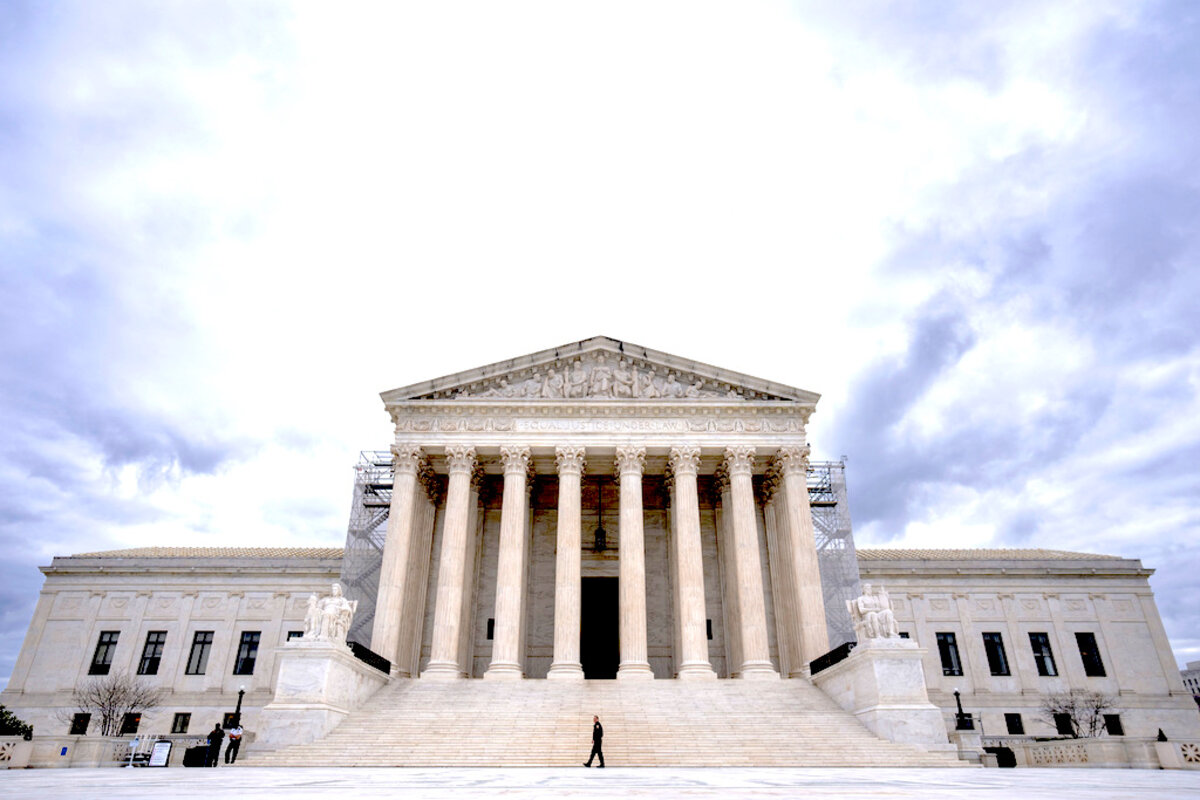
Two years ago, a New York Times columnist concluded that political polarization among Americans “has created its own vicious circle.” It has been “weeding out moderates, fostering extremists and constraining government action even in times of crisis.” Yet with what many Americans now perceive as a crisis – the possible reelection of Donald Trump as president – the Supreme Court on Monday tried to set an example of calm consensus-making.
In a ruling that itself could have been highly polarized, all nine justices agreed that the Constitution does not allow states to bar Mr. Trump from a ballot for federal office even if a state deems the former president guilty of insurrection for the Jan. 6, 2021, attack on Congress, as Colorado had done in this case.
One justice in particular, Amy Coney Barrett, wanted people to know how much the court worked together for judicial harmony. “The Court has settled a politically charged issue in the volatile season of a Presidential election,” she wrote in a concurring opinion. “Particularly in this circumstance, writings on the Court should turn the national temperature down, not up.
“For present purposes, our differences are far less important than our unanimity: All nine Justices agree on the outcome of this case. That is the message Americans should take home.”
One minor difference among the justices was on whether Congress or another entity should now, after this decision, set the rules for barring candidates under the post-Civil War constitutional amendment aimed at keeping insurrectionists from holding federal office. A majority who supported the role of Congress acknowledged the minority’s dissent. Yet it added that all the reasons given in the ruling help “provide a complete explanation for the judgment the Court unanimously reaches.”
The ruling hints that the current justices, despite past court decisions that widened political divisions, are selecting cases and deciding on them in ways to lessen polarization. The fact that the court so quickly decided this case to accommodate the presidential primaries shows it may be mindful of its public role in taking measured and deliberative approaches to groundbreaking questions.
When asked what she saw as threats to the rule of law, the late Justice Ruth Bader Ginsburg replied, “The problems of indifference, of tribal-like loyalties, lack of observance of the golden rule, ‘Do unto others.’” She and her ideological opponent on the court, the late Justice Antonin Scalia, were friends with a high respect for one another. They often helped take harsh edges off the other’s written opinions.
Perhaps a similar respect among the current justices was behind Monday’s unanimous decision. For Americans who won’t even talk to their political opposites, that is indeed a message to “take home.”

A Christian Science Perspective
Each weekday, the Monitor includes one clearly labeled religious article offering spiritual insight on contemporary issues, including the news. The publication – in its various forms – is produced for anyone who cares about the progress of the human endeavor around the world and seeks news reported with compassion, intelligence, and an essentially constructive lens. For many, that caring has religious roots. For many, it does not. The Monitor has always embraced both audiences. The Monitor is owned by a church – The First Church of Christ, Scientist, in Boston – whose founder was concerned with both the state of the world and the quality of available news.
Let Love shape your view
- Quick Read
- Read or Listen ( 3 Min. )
-
By Larissa Snorek
Letting God inform our perspective of ourselves and others frees us from unhelpful rumination over perceived flaws and opens the door to joy and progress.
Let Love shape your view
How frequently the morning’s bright prospects for our day seem diminished by nightfall. From goals not met to things we wish we’d done differently or didn’t do that we wish we had, so many little failings can leave us feeling discouraged and defeated. Yet, as we gain a right concept of God, we begin to glimpse a new, reliable reality.
The author of First John in the Bible gives a boundless, thought-provoking concept of God as Love (see 4:8). This broadens our perspective of life and ourselves – moving us out of the weariness that comes from being all too aware of our shortcomings.
John the Baptist proclaimed about Jesus, the individual who exemplified the idea of God as Love, “Look, there is the lamb of God who will take away the sins of the world!” (John 1:29, J.B. Phillips, “The New Testament in Modern English”). These “sins” might not be intentional choices to do or think wrongly. Sometimes they are just the cumulative effects of holding on to a conventional view of life as material, which could foster a harshness in us or make us entertain a subtle but routine self-condemnation – a chronic worry that we won’t ever become better.
Jesus showed humanity the Christ, the true idea of God. And if Christ is able to take away the sins of the world, then how natural it is that it would also be able to eliminate the little failings that seem so prevalent in our own daily lives. Turning our thought to God, we gain an understanding of the power of divine, all-pervasive Love. And we begin to think and act from a foundation of compassion and pure affection toward ourselves and others.
Such a commitment lifts our experience above everyday annoyances and irritations, no matter how legitimate they seem, that tend to render us unhappy and unsatisfied. As we begin to discern the truth of God as Love, we feel more dominion and joy in our lives and a grander sense of purpose in our daily activities. We discover the reality of ever-present spiritual good and lose a false sense of life as anything less.
Our idea of God determines our grasp of what is real and true. The fact that God is Love is shown in the life and prolific healing work of Christ Jesus. He not only taught the reality of God but showed how understanding God and trusting in divine Love change thought and experience from discouragement and struggle to joy and freedom. Christian Science shows that our individual selfhood belongs entirely to God – that God, Mind, is the source of all good. Understanding this, we learn to trust in the higher order of things – to accept the reality of universal, God-directed harmony as surely as we recognize the harmony and order of the planets orbiting in the solar system.
This is more than just a comforting thought. As we realize that our selfhood is wholly in and of God, we lose any sense that letting go of limiting patterns of thought or outgrown ways of thinking and living is an arduous or sometimes fruitless human effort. Through Christ, we find that joy is our reality.
The human mind tends to rehearse hardships and failures, as if giving them more thought will somehow help overcome them. But recently, when I found myself enmeshed in rumination about a rough start to the new year, in turning Godward, I was reminded of a moment of true joy. Something lovely and good had occurred, yet been promptly forgotten. And I felt transformed by the reminder. I’d been analyzing many little failings, but this touch of Christ made starkly clear that the things I’d been rehearsing weren’t at all the reality. That moment of joy was the reality – not just for that moment but for always.
As thought turns wholeheartedly to God, we see the spiritual good that is always present. We gain a true idea of the allness of God as Love and stop giving attention to any opposite story. God, as divine Mind, is recognized as the source of all the intelligent and fulfilling activity in the universe. The power of Love rescues us, reminding us of what is real and showing us the unreality of anything less than God’s expansive love and goodness.
Adapted from an editorial published in the Feb. 26, 2024, issue of the Christian Science Sentinel.

Viewfinder
Seeking a signal

A look ahead
Thanks for joining us as you start your week. Tomorrow, watch for our story from Mexico City-based correspondent Whitney Eulich, on how shelters and clinics serving migrants on the U.S.-Mexico border adapt to ever-changing policies.




